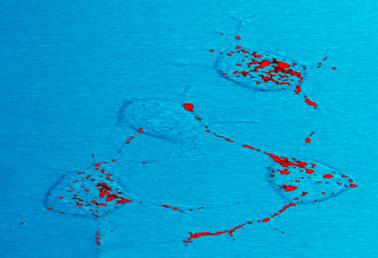

Prion protein, shown in red, can become infectious and cause neurodegenerative disease. Here four nerve cells in a mouse illustrate how infectious prion protein moves within cells along neurites – wire-like connections the nerve cells use for communicating with adjacent cells.
Prion protein, shown in red, can become infectious and cause neurodegenerative disease. Here four nerve cells in a mouse illustrate how infectious prion protein moves within cells along neurites – wire-like connections the nerve cells use for communicating with adjacent cells.
Prion diseases are transmissible, untreatable, and fatal brain diseases of mammals. Their cause is highly unusual: The host’s normal prion protein can, for unknown reasons, malfunction and assemble into structured aggregates called prions that cause infectious brain disease. This process – which can be underway for years before symptoms appear – likely causes the most common form of prion disease in people, sporadic Creutzfeldt-Jakob disease (CJD). Other forms of human prion diseases include variant CJD, fatal familial insomnia, Gerstmann-Straussler-Scheinker Syndrome and Kuru.
In livestock and wildlife, prion diseases such as scrapie (sheep), chronic wasting disease (deer, elk, moose), and mad cow disease (cattle) can spread by casual contact or contamination of feeds or the environment. Prions also can be infectious if inadvertently transferred from person to person by invasive medical procedures.
Prion disease symptoms reflect the brain being destroyed and can range from memory loss and unstable movement to being unable to sleep or realize the need to eat.
NIAID scientists have focused research on prion structures, biochemistry, cell biology, pathogenesis, diagnostics, and therapeutics. NIAID also is exploring similarities between prion diseases and other protein misfolding diseases, such as Alzheimer’s and Parkinson’s diseases, Lewy body dementia, and chronic traumatic encephalopathy.
To learn about risk factors for prion diseases and current prevention and treatment strategies visit the Centers for Diseases Control and Prevention (CDC) prion diseases site.
What's New
Latest News Releases
NIAID Now Blog
- NIAID Study Reveals, Compares Prion Strains
July 13, 2022
Biology & Genetics
Prion diseases are associated with the prion protein, which is found in many body tissues, including the brain. Normally, prion protein does not cause disease and resides on the surface of many cell types. Though under investigation, scientists think normal prion protein might help protect the brain from damage. They do know that when many normal prion protein molecules change their shape and clump together, they can aggregate in brain tissue and form the infectious prions that cause prion disease. Prion diseases are therefore caused by an infectious, abnormally shaped and aggregated prion protein. Scientists are not sure why normal prion protein become misshapen. NIAID scientists co-discovered the prion protein gene and were among the first to show that abnormal prion protein can change normal prion protein to the abnormal, infectious form.
Therapeutic Approaches
Although there are no known ways to cure prion diseases, scientists around the world are working to develop treatments and diagnostics. NIAID researchers have developed a rapid diagnostic test for prion diseases. Using test-tube or cell-based models of prion infection for fast initial screening, NIAID researchers also have tested thousands of compounds and identified hundreds of molecules that inhibit the formation of the abnormal, infectious form of prion protein. Further testing of the most potent of these inhibitors has revealed several that can prolong the lives of rodents even if treatment begins after infection.
Animal Prion Diseases and Humans
There are 3 major prion diseases in animals: scrapie in sheep, bovine spongiform encephalopathy (BSE) in cattle, and chronic wasting disease (CWD) in deer, elk and other cervids. NIAID scientists use various experimental models to study how prions from one animal species can infect different animal species. These include studies to determine whether animal diseases such as CWD can infect people and cause Creutzfeldt-Jakob disease (CJD).

